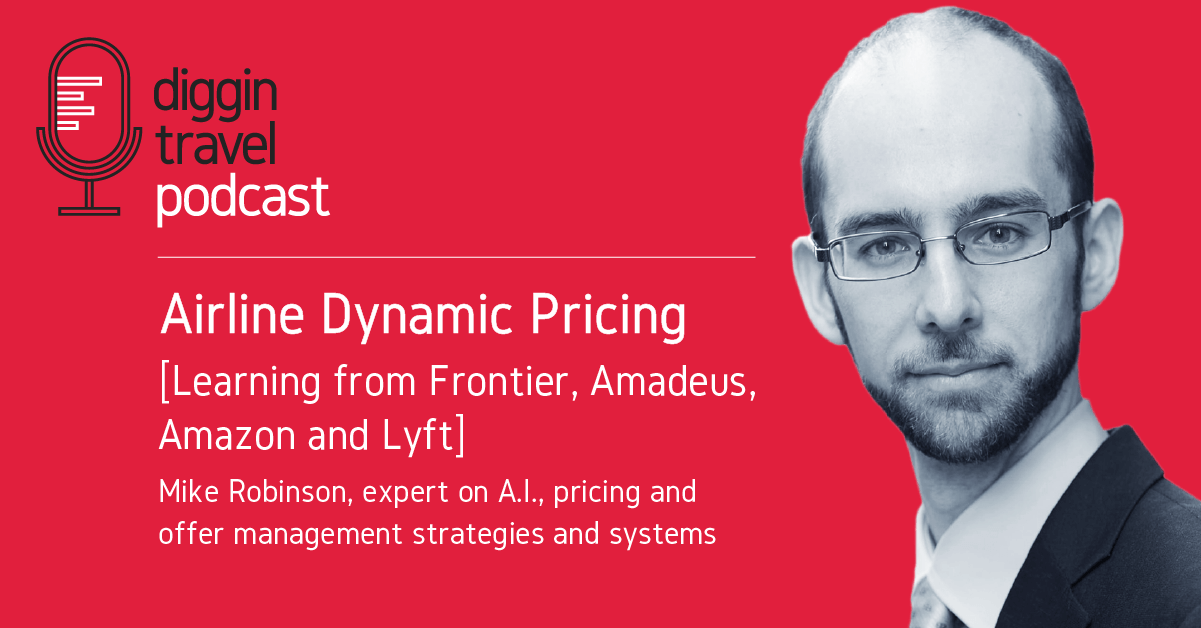Select Sidearea
Populate the sidearea with useful widgets. It’s simple to add images, categories, latest post, social media icon links, tag clouds, and more.


hello@youremail.com
+1234567890
+1234567890
Populate the sidearea with useful widgets. It’s simple to add images, categories, latest post, social media icon links, tag clouds, and more.


Iztok Franko

Given the recent changes, we have been placing significant emphasis on data science at Diggintravel, recognizing it as a logical choice. And if I were to pinpoint the most significant area for airlines where data science can have a substantial impact, it would undoubtedly be in airline dynamic pricing and dynamic offers, which can be seen as the holy grail.
However, leveraging artificial intelligence to build dynamic pricing is not an easy task for airlines. This is why we talked to an expert who has tons of experience building airline dynamic pricing products and teams.
Mike Robinson has worked in various business and technology (biztech) roles, integrating data science and technology into teams focused on revenue growth or innovation. Mike’s most recent experience was at Amazon, working on the Prime Team and CRM, as well as at Lyft, a rideshare company. Prior to that, he worked in the airline industry for a long time, at Amadeus Team in Nice and Frontier Airlines in Denver.
Listen to the new episode of the Diggintravel Podcast to learn about how to build dynamic pricing in the airline environment, or read on for key highlights from our talk with Mike:
And don’t forget to subscribe to the Diggintravel Podcast in your preferred podcast app to stay on top of the latest airline data science, digital optimization, and UX trends!
Availability of big data and advancements in machine learning and artificial intelligence have revolutionized many industries, including the airline industry, allowing for the implementation of customized pricing and offer management. Mike shared his experience on this journey and highlighted the importance of data availability and the democratization of artificial intelligence.
A lot of the concepts from machine learning are 40-50 years old, but they just weren’t practical because nobody had the scale of data to make them usable. In between when I got into the airline industry in 2013 and when I went to Amazon, all of a sudden this Big Data revolution made it possible for an airline like Frontier – and no offense to Frontier, but Frontier is not a huge business, did not at the time have piles and piles of capital – could all of a sudden be leveraging big data to use machine learning to drive systems innovations, and to drive the use of artificial intelligence. And that’s phenomenal.
And this is, of course, not limited to airlines, this democratization of artificial intelligence that comes in part by the technology, but also the thing we shouldn’t forget is the data availability, which was really revolutionary. So I think that’s something that’s probably pretty familiar with folks here. I feel like customized pricing and offer management is something that has become broadly acceptable across the industry as a target. We were making great progress, as I said, at Frontier. I had a really wonderful team working with me. We had a biztech team that was focused on ancillary product development, ancillary pricing. We transitioned from flat pricing to fully dynamic pricing.
We are in the middle of an artificial intelligence revolution, with the boom of platforms like ChatGPT. Mike worked on integration of machine learning and artificial intelligence into dynamic pricing and offers systems at Amadeus and Frontier Airlines way before the recent boom started, so I was curious about the biggest challenge he faced.
“Probably the biggest challenges relate to how infrastructure was set up. If you didn’t have an infrastructure that could support any machine learning, you risked spending money, time, and energy on producing a machine learning outcome that ended up in a report and ended up on a PowerPoint.”
Nothing frustrates senior executives like efforts that result in just a report without actionable outcomes. Mike shared two examples of how he and his teams convinced the executives to invest in data science.
At Amadeus, this was all about integrating all of this capability so that it would function, and clear understanding that Amadeus’s airline customers were not interested in using machine learning to get some sort of an insight and then go off and keep doing what they were doing, but actually integrating it into the Altea platform.
At Frontier, we had to bring things together in a different way, largely because we were dealing with very different time scales. Amadeus develops the Altea platform. They’ve got I think it was 350 airline customers. It is a big deal, and changes cannot be made in a matter of months, whereas at Frontier, Frontier was going through very rapid transition, very rapid expansion, and really needed to see the sort of improvement that could really only be brought by artificial intelligence very rapidly. It was necessary to really communicate, and at the board level, what it entailed from that kind of biztech perspective – that you can’t just hire a data scientist and say, “Why isn’t this working?” because that data scientist doesn’t have the data that they need why the output can’t flow through the systems.
So we had to produce, effectively, a 3-year plan and present that to the board and say, “It requires this investment that goes across the entire system. So we do need data science capability. We need the data capability. We also need a means to be able to effect this.” What we said time and again is, “Each one of these seems like it may be a discrete area of investment, but if you don’t do all of them, you’ll get a fraction of the benefit from doing any of them.”
Of course, I was curious to hear about the end result and how it worked in practice.
At the end was actually dynamic pricing, and it was dynamic offer management, which we’ve talked about and has been part of the goal at Frontier, part of the goal at Amadeus. That was what we were working on very hard. At Frontier, the fully dynamic pricing launched and was very successful, improvement for customers, improvement for the business. We were on our journey when COVID hit, and that changed everything, of course.
Frontier also offers ancillary bundles, which was an innovation that we launched in 2015. It’s a great way to offer customers a way to get more without necessarily being the sum total of each a la carte product. The way that it works is when customers come in, Frontier is using artificial intelligence to determine the best offers for this customer based on a host of factors. This includes looking at previous customers, using that customer value, but also marketplace considerations. Frontier is a business; Frontier needs to produce profits. All of those things go into the artificial intelligence that then changes those prices so that customers are seeing the best price for them at that moment for that flight.
One of the big takeaways Mike had from his time at Amazon and Lyft was around organization and planning. Mike sees some airlines following suit when it comes to organization of data-driven pricing teams.
The way that tech teams that I’ve worked on are structured follows this biztech concept where you have a relatively small team compared to a lot of legacy companies that is around a relatively sharply defined business area, and it includes the data science, the engineering team, the business team who are responsible for those metrics. This is enabled because of a couple of things. One is the push toward microservices, away from a large technology solution which then is supported by a large technology team that really can’t be split apart. Now we’re moving away from that to microservices, so you can have a discrete engineering team that’s quite small that’s working on a specific service that it owns that it does something specific and interacts with other services.
Mike mentioned another trend that we’ve discussed previously in our Airline Data Science Talks – that is, the merging of data science and business roles.
On the data science side, likewise, it might have made sense when data science was very complicated and when data storage was very expensive to try to centralize that function. But now, data storage is really, really cheap and data science, as you were saying, has been so democratized, it’s actually much more important to have those data scientists very, very close to the engineers and to the business team that they’re trying to support. This is the way that organizationally, you have this small team that is responsible for the science, the tech, and the business metrics.

Of course, we couldn’t have an airline data science discussion without talking about ChatGPT and the possibilities it brings for airlines. A really intriguing area we discussed was the limitations of airline search forms and the potential for improvement through technologies like ChatGPT and natural language processing.
Current search forms restrict the analysis of customer demand, while using more interactive and unstructured data could reveal additional insights, such as demand for products or routes not currently offered. This is an opportunity for the industry to make long-awaited changes to the traditional search form, which has remained largely unchanged for several decades.
I think that’s where some of this natural language processing capability is actually really exciting for travel; it opens up the possibility for us to have much more of a conversation around what that customer is trying to achieve rather than trying to infer it, especially once they’ve arrived. I think there are some folks who’ve done some really fascinating things about asking people, “What kind of trip do you want to take? Where do you want to go?”
And you really see, if you combine with natural language processing can do with all that we’ve already got in terms of the selling intelligence – you could have somebody literally say, “I’m interested in taking a vacation,” and rather than what ChatGPT would do is say, “Well, beaches are nice and mountains are nice,” you would actually be able to predict what a really relevant, intelligent response is beyond the sort of thing that ChatGPT can do, but leveraging the natural language plus all the intelligence that we’ve developed in selling travel using artificial intelligence over the last 10 years. I think that’s very, very, very exciting.
We discussed many other airline dynamic pricing and data science related topics with Mike, so make sure to listen to the full podcast interview to learn more.
If you want to learn from leaders like Andres about data science and digital products or want to be the first to know when our next Airline Digital Talk will be published, please:
I am passionate about digital marketing and ecommerce, with more than 10 years of experience as a CMO and CIO in travel and multinational companies. I work as a strategic digital marketing and ecommerce consultant for global online travel brands. Constant learning is my main motivation, and this is why I launched Diggintravel.com, a content platform for travel digital marketers to obtain and share knowledge. If you want to learn or work with me check our Academy (learning with me) and Services (working with me) pages in the main menu of our website.
Download PDF with insights from 55 airline surveyed airlines.
Thanks! You will receive email with the PDF link shortly. If you are a Gmail user please check Promotions tab if email is not delivered to your Primary.
Seems like something went wrong. Please, try again or contact us.


No Comments